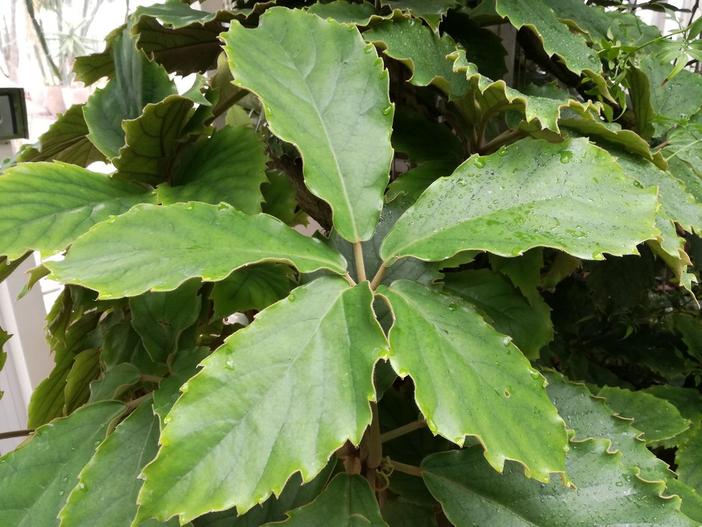Chestnut Vine
(Tetrastigma voinierianum)
Chestnut Vine (Tetrastigma voinierianum)
/
/

Jungle Rebel
CC BY 2.0
Image By:
Jungle Rebel
Recorded By:
Copyright:
CC BY 2.0
Copyright Notice:
Photo by: Jungle Rebel | License Type: CC BY 2.0 | License URL: https://creativecommons.org/licenses/by/2.0/ | Uploader: Jungle Garden | Publisher: Flickr















Estimated Native Range
Summary
Tetrastigma voinierianum, commonly known as chestnut vine or lizard plant, is a vigorous evergreen vine native to the limestone cliffs and monsoon forests of Laos and Vietnam. It is also found in similar habitats in other parts of Southeast Asia. This species can reach lengths of over 15 meters when supported. The chestnut vine has large, glossy, palmate leaves that can create a lush, tropical feel in any setting. It does not commonly flower or fruit outside its native range, but when it does, the flowers are small and inconspicuous, followed by inedible fruits.
The chestnut vine is valued for its ornamental foliage, which has earned it the Royal Horticultural Society’s Award of Garden Merit. It is well-suited for growing in conservatories, greenhouses, or as a houseplant in cooler climates. In cultivation, it requires a sturdy support structure due to its climbing habit. The plant thrives in part shade to full shade and prefers consistently moist, well-drained soil. It is relatively easy to maintain but may require regular pruning to manage its vigorous growth. While it is not known for significant pest or disease issues, it can suffer from root rot if overwatered or planted in poorly draining soils. It is not considered invasive outside its native range but should be monitored to ensure it does not overtake other plants in the garden.CC BY-SA 4.0
The chestnut vine is valued for its ornamental foliage, which has earned it the Royal Horticultural Society’s Award of Garden Merit. It is well-suited for growing in conservatories, greenhouses, or as a houseplant in cooler climates. In cultivation, it requires a sturdy support structure due to its climbing habit. The plant thrives in part shade to full shade and prefers consistently moist, well-drained soil. It is relatively easy to maintain but may require regular pruning to manage its vigorous growth. While it is not known for significant pest or disease issues, it can suffer from root rot if overwatered or planted in poorly draining soils. It is not considered invasive outside its native range but should be monitored to ensure it does not overtake other plants in the garden.CC BY-SA 4.0
Plant Description
- Plant Type: Vine
- Height: 12-25 feet
- Width: 12-25 feet
- Growth Rate: Moderate
- Flower Color: N/A
- Flowering Season: Spring
- Leaf Retention: Evergreen
Growth Requirements
- Sun: Part Shade, Full Shade
- Water: Medium
- Drainage: Medium
Common Uses
Bank Stabilization, Border Plant, Potted Plant, Rock Garden
Natural Habitat
Native to limestone cliffs and monsoon forests of Laos and Vietnam
Other Names
Common Names:
Scientific Names: , Tetrastigma voinierianum, Vitis voineriana, Vitis voinieriana, Cissus voinieriana,
GBIF Accepted Name: Tetrastigma voinierianum (Baltet) Pierre ex Gagnep.